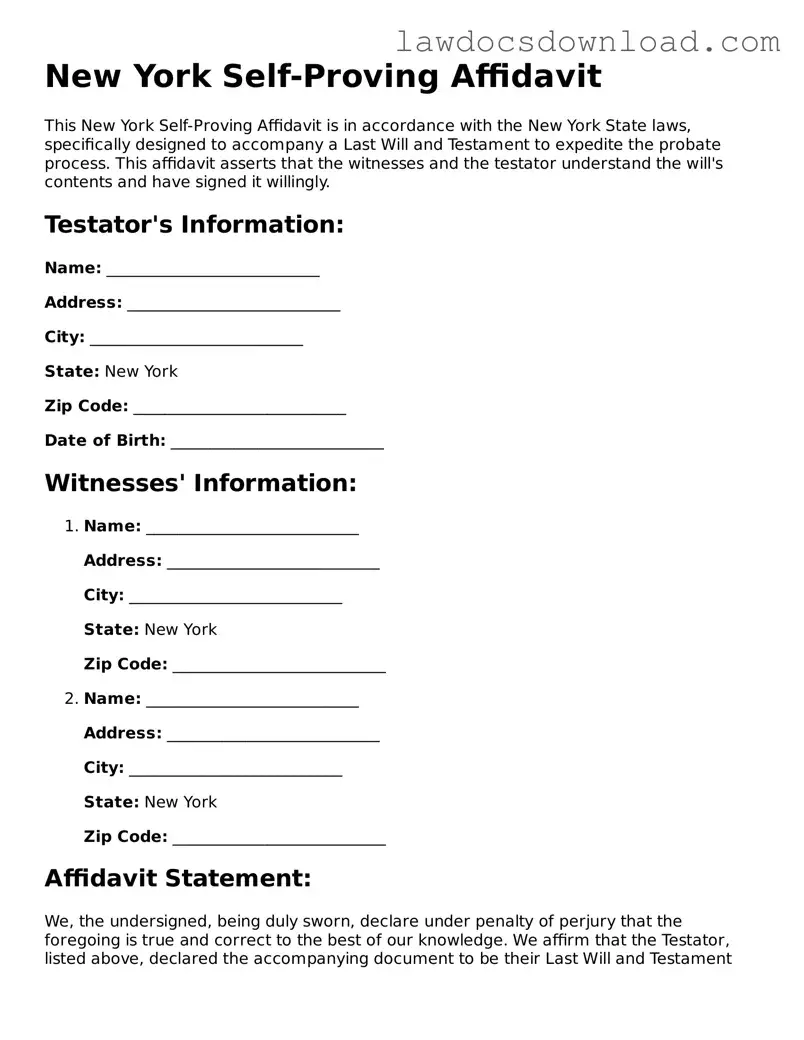The New York Self-Proving Affidavit form shares similarities with a Last Will and Testament, particularly because both documents require the signature of witnesses to validate the legitimacy of the document. Just as a self-proving affidavit streamlines the probate process by verifying the authenticity of the signer's signature, a Last Will and Testament becomes enforceable only after it is signed by witnesses, thereby confirming the decedent's intentions.
Comparable to a Power of Attorney (POA), the self-proving affidavit enhances the legal standing of a document by providing a sworn statement that confirms the document signer's identity and willingness. A POA, which grants someone the authority to act on another's behalf, also relies on notarization for its validity, emphasizing the signer's conscious consent and understanding, mirrored in the purpose of a self-proving affidavit.
Living Wills and self-proving affidavits are alike in that they both articulate the signer's intentions, witnessed and notarized to ensure authenticity. While a Living Will outlines medical wishes in the event the individual becomes incapacitated, the self-proving affidavit supports the authenticity of a document, making both crucial for upholding the signer's desires under specific circumstances.
Trust Agreements and self-proving affidavits share the common purpose of facilitating a smoother legal or administrative process. Trust Agreements, which outline the management and distribution of an individual's assets, often include language to make them self-proving, thereby expedited in recognition and execution, much like self-proving affidavits do for wills and other legal documents.
Medical Directives, much like self-proving affidavits, are legal documents that require notarization and sometimes even the presence of witnesses to ensure that the document reflects the true wishes of the individual regarding medical treatment preferences. This process underscores the document's validity and the individual's informed consent, paralleling the intention behind a self-proving affidavit.
Deeds, especially those transferring real estate ownership, often accompany a self-proving affidavit to validate the signatures involved in the transaction. This verification process reinforces the document's authenticity, ensuring that transfers of ownership are recognized officially without dispute, similar to how self-proving affidavits lend credence to wills and other legal documents.
Guardianship Forms, designed to establish a legal guardian for minors or incapacitated individuals, benefit from the addition of a self-proving affidavit to confirm the accuracy and truthfulness of signatures. This formalizes the guardian's appointment in a manner that's readily accepted by courts, mirroring the role self-proving affidavits play in reinforcing the legitimacy of various legal documents.
Pre-nuptial Agreements, akin to self-proving affidavits, receive enhanced legal validity through notarization. This process verifies each party's agreement to the terms laid out regarding the division and protection of assets in the marriage, ensuring that the document can be quickly and effectively enforced if necessary.
Mortgage Documents often incorporate self-proving affidavits as part of their comprehensive package to affirm the identity of the signatories and the genuineness of their signatures. This verification streamlines the loan process, similar to how a self-proving affidavit expedites the validation of a will or other legal documents in estate planning.
Finally, Business Contracts, like self-proving affidavits, necessitate notarization or witness signatures to underscore the agreement's enforceability. Ensuring that all parties have willingly agreed to the terms, these measures validate the contract similarly to how a self-proving affidavit certifies the authenticity of signed legal documents.
